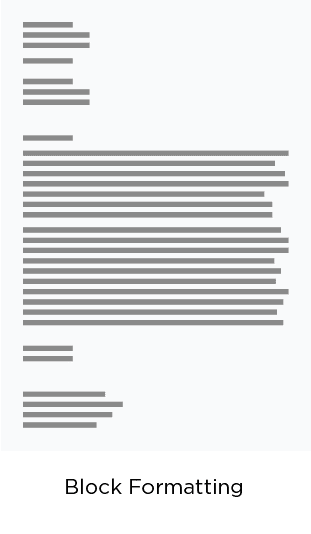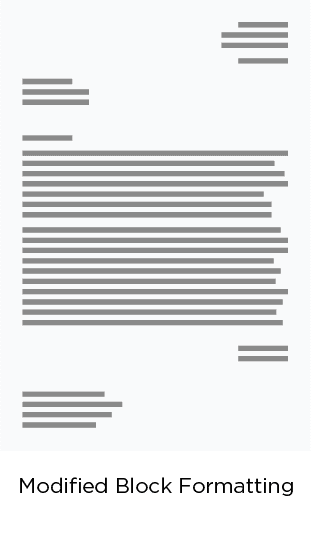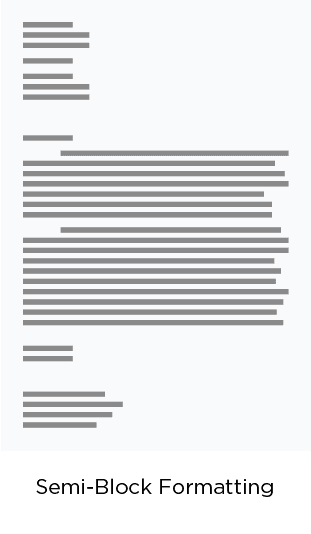Key Takeaways
- A business letter has seven main parts, including the sender’s and recipient’s addresses, the date, a greeting, the body, a closing, and any extra documents.
- To make your business letter look neat and easy to read, use left alignment, single spacing, a simple font like Times New Roman and 1-inch margins. If you use a company letterhead, adjust the layout to fit it properly.
- Your letter should sound professional and clear. Use simple words, get to the point quickly and always check for grammar or spelling mistakes before sending.
Learning how to write a corporate letter correctly helps you communicate clearly, set the right tone, and make a strong impression. Whether you’re following up with a client, making a formal request, or sending a thank-you note, following the correct format of a business letter helps ensure your message is both received and respected.
What Are the 7 Parts of a Standard Business Letter Format?
Sender’s address
You don’t want the recipient to have to look up your address to write a response, so your return address should appear at the top of the page, aligned to the left margin. Include your full name, company name (if applicable), street address, city, state, and ZIP code. Including a phone number and email address with the sender address is optional, but can make it easier for the recipient to respond quickly.
Date
What is the standard format for a business letter date? Use the full date format—like “August 4, 2025”—and place it one line below the sender’s address. If you’re using a modified block style, the date may be aligned with the center point or right-hand side of the page. Using the correct business letter style makes it immediately apparent when the letter was written. That way, the recipient is aware of its urgency, especially if it revolves around a particular event or business situation.
Recipient’s address (inside address)
You don’t want your assistant to have to look up the address to send the letter (or you don’t want to have to look up the address again yourself). This section goes one line below the date and includes the recipient’s full name, job title, company name, and business address. The inside address should match what appears on the envelope, helping ensure the letter reaches the right person.
Salutation
Opening with a generic phrase like “Dear Madam” or “To whom it may concern” is a surefire way to get your letter lining a wastepaper basket. The most effective format for business letters includes a name in both the address and salutation. You may have to call up the company or do some searching on LinkedIn to find out who the letter should go to. If you can’t find a name, use a professional alternative like “Dear Hiring Manager.”
Body
This is where you get to the main point. As with any communication, being clear and concise tends to reflect best on the writer. The first paragraph should explain why you’re writing. The paragraphs that follow should expand on your request, idea, or feedback clearly and professionally. Use a new body paragraph for each main idea, and keep the message focused. Your last body paragraph should restate your purpose and invite follow-up if needed.
Closing/signature
The signature gives a personal touch to the letter, shows exactly who it’s from and demonstrates that you approve of the content. End with a courteous phrase such as “Best regards” or “Sincerely.” Wondering if there should be a space between sincerely and your name? Yes! Leave at least one blank line (or four if printing and signing by hand) between the closing and your typed name. If printing the letter, use blue or black ink for your handwritten signature. For clarity, include your job title and company name below it.
Enclosures
How should a business letter typically end? If you’re following the best form for a business letter, you should include a list of any additional documents enclosed with the business letter, in case the recipient misplaces them. Mention each one under the word “Enclosures” after the last line of the last paragraph. For example, “Enclosures: résumé, brochure.” This helps the recipient know what to expect and track items if something goes missing.
Business Letter Formatting Tips
A formal business communication can be the first impression that perspective clients, employees and other stakeholders have of you, so it’s important to make sure it’s a good one. Having the right formatting in a business letter will display your professionalism and your respect for the recipient. So, how do you format a letter for business? Follow the recommendations below.
Spacing
Letters should be single-spaced between sentences in order to maximize space on the page. Include four line breaks between the letter’s closing sentence or paragraph and your printed name to leave space for your signature. The rule of thumb here is that utility and readability trump individuality.
Alignment
All proper business letter styles are left-aligned. The common wisdom over the decades is that such alignment is best for readability.
Font
The standard font style is Times New Roman, size 12, though other commonly used fonts such as Arial and Helvetica are acceptable. Readability is crucial when it comes to fonts, so avoid getting creative and using hard-to-read gothic or cursive fonts. If your letter’s body is running out of space on a single page, it’s better to cut it down than reduce font size.
Margins
Most experts agree that 1″ margins are the best for business letters because they maximize space, though you may have to make room for a letterhead if you’re using it.
Letterhead
You might also consider using a business letter format with letterhead for your company’s letters because it offers a professional appearance and is also informative. The letterhead should display the company’s mailing address, phone number and any other contact information. If using letterhead, you will need to remember to adjust the margins and formatting accordingly.
Tone
The right company letter format balances professionalism with approachability, helping ensure that you are taken seriously. Here are some important tips when it comes to setting the appropriate tone in the letter:
- Stay professional, but write in a natural, conversational tone.
- Be clear and direct by stating your main point early.
- Avoid sounding boastful or aggressive.
- When delivering bad news, soften the message with empathy and keep the door open for continued dialogue.
- For complaints, express concerns politely and offer a constructive solution.
- For memos, use a crisp, no-frills tone focused on internal communication.
A well-composed tone helps your letter feel purposeful and productive, making it more likely you will accomplish your business goals.
Word Choice and Grammar
Impact is greatest when the right format of a business letter is paired with strong word choices that build trust and reinforce credibility. But good writing isn’t about big words—it’s about clarity. Here are a few top tips:
- Keep your message sharp and simple.
- Avoid filler words, like “just,” “maybe,” or “probably.”
- Steer clear of jargon.
- Choose words that reflect action and ownership.
- Use an active voice. For example, “We can schedule your installation by Friday,” instead of “Your installation will be scheduled by Friday.”
And remember: proofreading is key. Grammatical errors come off as careless. For important messages, ask another person to review your draft or run a grammar check online.
Punctuation
Proper punctuation helps your message land clearly. Here are a few quick tips to follow:
- Use a colon after the salutation (e.g., “Dear Mr. Lee:”), not a comma.
- End your last paragraph with a period, even in short sign-offs.
- Use commas to separate items in a list.
- Don’t overuse exclamation points. One per letter is plenty, if at all.
- Check for misplaced apostrophes and quotation marks.
From the first word to the last, clean punctuation shows attention to detail, helping your letter stand out for the right reasons.
Business Letter Format Examples
To indent or not to indent? That is the question. This is really a matter of how formal you want the letter to look. You might want a block format to convey formality if you’re complaining about something, but a semi-block might communicate a nice, “formal light” look in a thank-you letter, especially if it’s someone you already know. So, what are the three main layouts of a business letter? Let’s take a look at each.
1. Block Formatting
If you don’t know which format of a business letter to use, block format is often the best option. Block format is mostly used in industries like business and law, but it can also be great for cover letters and reference letters. The entire letter is justified left and single-spaced except for a double space between paragraphs. With a simple font like Times New Roman and black ink, you can’t go wrong with this classic format.

Ms. Tanya Smith, CEO
Acme Corp.
12345 Acme Ave.
Minneapolis, MN 55410
(612) 555-2368
June 1, 2025
Mr. Oscar Wilde, VP of Sales
NewTech
9876 NewTech Way
San Jose, CA 95113
Dear Mr. Wilde:
I would like a free consultation about NewTech’s cloud-based sales management software. Acme Corp. is a fast-growing manufacturer (20% annual revenue growth over the past five years). We want to continue to grow, and NewTech’s software seems like a product that might take our sales team to the next level. I want to explore with you whether NewTech software is a good fit for Acme.
I look forward to speaking with you at your earliest convenience.
Sincerely,
Tanya Smith, CEO
Enclosures: Acme Corp. brochure
Note that this is a more formal type of business letter: no indentations and everything is on the left justify. If you’re questioning how formal the letter should appear, it’s probably best to play it safe and go with a block format.
2. Modified Block Formatting
Modified block format is slightly different from the block format. The entire text is aligned to the left except for the date, sender’s address and closing. Modified block format is another commonly used business letter format, but it’s slightly less formal than block format.

Ms. Tanya Smith, CEO
Acme Corp.
12345 Acme Ave.
Minneapolis, MN 55410
(612) 555-2368
June 1, 2025
Mr. Oscar Wilde, VP of Sales
NewTech
9876 NewTech Way
San Jose, CA 95113
Dear Mr. Wilde:
I would like a free consultation about NewTech’s cloud-based sales management software. Acme Corp. is a fast-growing manufacturer (20% annual revenue growth over the past five years). We want to continue to grow, and NewTech’s software seems like a product that might take our sales team to the next level. I want to explore with you whether NewTech software is a good fit for Acme.
I look forward to speaking with you at your earliest convenience.
Sincerely,
Tanya Smith, CEO
Enclosures: Acme Corp. brochure
Note that there are still no indentations, but everything doesn’t line up on the left. It’s just a bit less formal. Smith might be wiser to stick with the block format in this case, but she might switch to modified block once she has a working relationship with Wilde.
3. Semi-block Formatting
Semi-block format is less commonly used. It’s similar to modified block format except that each paragraph is indented instead of left-justified. Semi-block format is a less formal option to keep in your business letter writing toolbox.

Ms. Tanya Smith, CEO
Acme Corp.
12345 Acme Ave.
Minneapolis, MN 55410
(612) 555-2368
June 1, 2025
Mr. Oscar Wilde, VP of Sales
NewTech
9876 NewTech Way
San Jose, CA 95113
Dear Mr. Wilde:
[Add Indentation] I would like a free consultation about NewTech’s cloud-based sales management software. Acme Corp. is a fast-growing manufacturer (20% annual revenue growth over the past five years). We want to continue to grow, and NewTech’s software seems like a product that might take our sales team to the next level. I want to explore with you whether NewTech software is a good fit for Acme.
I look forward to speaking with you at your earliest convenience.
Sincerely,
Tanya Smith, CEO
Enclosures: Acme Corp. brochure
Note that this is pretty much a block format, but the paragraphs have indentations. If you’re debating whether to use block or modified block format (or simply hate looking at paragraphs without indentations), semi-block is a nice compromise.
Final Thoughts on Business Letter Formats
Writing business letters is a fundamental skill for any business owner and your professional life in general. A well-written letter shows that you mean business because you took the care and time to write, format, print and mail it. If a business gets a written complaint in the mail, odds are that the author is not going to let the matter drop. Similarly, a written thank you letter is much more powerful and effective than thanks conveyed via email.
A formal business letter, however, loses its power if its formatting is unprofessional, if it sets the wrong tone, if it’s poorly written, or if it includes grammar and spelling mistakes. So it’s important to learn how to do them right.






What a great article. really appreciate.
I’m very interested
That’s great to hear, Jason! You can learn more about business letters by also reading through these SBA articles:
https://sba.thehartford.com/business-management/business-questions/writing-business-letters/
https://sba.thehartford.com/business-management/marketing/parts-of-a-business-letter/
This site was very useful to me.
That’s great to hear! Thank you for the positive feedback.
Amazing.
Indeed, this is helpful and has opened a lot to me.
That’s great to hear, Joseph!
I wanted to say that these articles have really helped me in my letter writings. Thank you for sharing your knowledge.
That’s great to hear! We’re happy to help. Thanks for reading SBA!
Please contact to me I want learn how to write official letter.
Thanks for reaching out! You can learn more about writing a business letter by reading this article: https://sba.thehartford.com/business-management/business-questions/writing-business-letters/
Thank you it helps me a lot.
You’re welcome!
Thanks for sharing this information.
Loved the blog!
You’re welcome, Sam! We’re so glad you liked it.
Thank you for the informative article.
That’s great to hear, Sean! We’re glad you found it informative. Here’s another SBA article on business letters you can check out too:
https://sba.thehartford.com/business-management/marketing/parts-of-a-business-letter/
Thanks for reading SBA!
Thank you so much.
You’re welcome, Jeanette!
Thanks! Huge help.
You’re welcome!
I loved seeing this info and learned a lot of new things from your article, can you write more about it?
Thanks! Great help.
You’re welcome! We’re glad it helped!
This article is really enhancing my letter-writing skill.
Thanks a lot Kelly Spors.
I would like to know the sources of your writing and suggested the recent letter writing books with authors names.
Thanks for accurate tips. Helped a lot.
Glad we were able to help, Noreen!
This article helped me a great deal in letting my students how important it is to be professional in writing business letters. As they say, what you are is what you write.
Thank you very much. Keep on pushing and posting items like this.
So glad you found the article valuable!